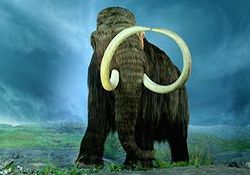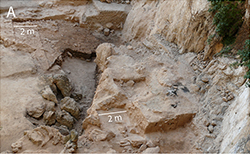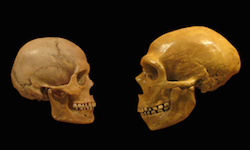
Proof Is in the Poop
What's in the Story?

A Neanderthal walks slowly, scanning the ground for tracks. He looks for anything that might lead to the mammoth he has been hunting. He finds a couple of tracks and quickens his pace. Suddenly, he also starts to see the tracks of a sabre-toothed cat, which make him decide that the area ahead is too dangerous to go through. So what will he eat for dinner? He doesn’t want to starve, so he must look for another source of food.
Scientists used to think that Neanderthals only ate meat. But recently, they’ve started to wonder if our meat-eating cousins also ate plants. Although there were many ways to try to figure out what Neanderthals ate, scientists used fecal matter (poop) to figure out what many of these creatures ate. In the PLOS ONE article, “The Neanderthal Meal: A New Perspective Using Faecal Biomarkers,” scientists analyzed the poop of Neanderthals to find out more about what they ate.
Meat, Meat, and More Meat

Many people believe that Neanderthals were simply hunters. When you think of them, you normally see a caveman, with a huge brow and forehead, wearing animal hides. They are hunting down wooly mammoths or other creatures to cook over a fire. But did our cavemen cousins also eat vegetables?
Scientists had already studied areas where Neanderthal fossils were found and shown that they might have eaten vegetables. At the Kebara Cave dig sites in Israel, scientists found plant remains near Neanderthal fossils. Another group of scientists studied the teeth of Neanderthals and found tiny plant fossils. Both of these findings suggested that Neanderthals may have eaten plants.
While these were excellent discoveries, it still was not enough to fully show that Neanderthals were eating plants. Maybe the plants just happened to be in the same area or the Neanderthals chewed on the plants but did not eat them. In order to know for sure that Neanderthals ate plants as well as meat, scientists turned to a different approach. They studied the Neanderthal’s poop.
Why Poop?

Everybody eats, and everybody poops. Dogs eat and poop. Humans eat and poop, and dinosaurs ate and pooped. In the same way, Neanderthals also ate and pooped. Therefore, when scientists wanted to figure out more about what Neanderthals ate, one of the best places to look is at what they left behind: their poop, also known as fecal matter.
In this experiment, scientists collected samples at El Salt, in Spain. This dig site is about 50,000 years old and is home to the oldest known Neanderthal fecal matter. Scientists dug up several samples of fecal matter, but also collected the soil around the samples. They wanted to make sure they gathered as much information about the fossilized fecal matter as they could. After they collected the samples, the scientists returned to the lab to analyze them.
Diet Discoveries
Back at the laboratory, the scientists wanted to identify what was in the samples that they had collected. To do this, they used a laboratory technique called Gas Chromatography-Mass Spectrometry (GC-MS). This technique is used to identify the different chemicals in a sample.
In order to prepare the samples, scientists took some of the fecal matter samples and crushed them up into a fine powder. They then soaked the powder in several different chemicals. Finally, they exposed the powder to high temperatures. This process helps to separate the different chemicals in a sample to figure out what it’s made of. In this experiment, scientists used this process to identify biomarkers in the fecal matter.
Biomarkers are chemicals that provide information about the organism they came from. In this case, scientists looked at biomarkers in poop samples. They did this to identify what kinds of foods the Neanderthals ate and how much of each type was eaten. This information is based on the fecal biomarkers identified by the GC-MS machine and how much of each one was present.

Scientists found two main biomarkers in the fecal matter samples they collected. They identified high levels of coprostanols, which are “meat-based” biomarkers. This confirmed that Neanderthals ate a lot of meat. Scientists also found “plant-based” biomarkers, called epistigmastanols. Finding these plant biomarkers meant that the Neanderthals also ate plants. The presence of both biomarkers told scientists that Neanderthals definitely had both plants and meat in their diets.
What Does It All Mean?
It’s a great discovery to know that Neanderthals ate plants, but why does it matter? Well, many scientists believed that Neanderthals did not survive as well because they only ate meat. If there were fewer animals around, it would be more difficult to find food to eat and survive.

If Neanderthals ate both meat and plants, then there would be more food sources available. They would be more likely to survive because they could eat plants if they were unable to hunt for food. Because Neanderthals also ate plants, scientists believe that a lack of food options was not a reason that they went extinct.
This diet information is also important because Neanderthals are closely related to modern humans. If Neanderthals ate plants, it tells scientists that they must have had similar digestive systems to modern humans. This information helps us understand how modern humans have evolved over time compared to early humans.
Additional Images provided by Wikimedia Commons. Image of Neanderthal skeleton and skin representation by Photario. Image of Neanderthal skull by Ecemaml.
Bibliographic details:
- Article: Proof Is in the Poop
- Author(s): Han Duerstock
- Publisher: Arizona State University School of Life Sciences Ask A Biologist
- Site name: ASU - Ask A Biologist
- Date published: 16 Feb, 2015
- Date accessed:
- Link: https://askabiologist.asu.edu/plosable/proof-poop-what-neanderthals-ate
APA Style
Han Duerstock. (Mon, 02/16/2015 - 07:03). Proof Is in the Poop. ASU - Ask A Biologist. Retrieved from https://askabiologist.asu.edu/plosable/proof-poop-what-neanderthals-ate
Chicago Manual of Style
Han Duerstock. "Proof Is in the Poop". ASU - Ask A Biologist. 16 Feb 2015. https://askabiologist.asu.edu/plosable/proof-poop-what-neanderthals-ate
Han Duerstock. "Proof Is in the Poop". ASU - Ask A Biologist. 16 Feb 2015. ASU - Ask A Biologist, Web. https://askabiologist.asu.edu/plosable/proof-poop-what-neanderthals-ate
MLA 2017 Style

Be Part of
Ask A Biologist
By volunteering, or simply sending us feedback on the site. Scientists, teachers, writers, illustrators, and translators are all important to the program. If you are interested in helping with the website we have a Volunteers page to get the process started.
